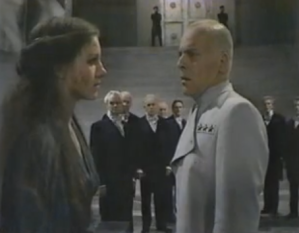 The Theban Plays, a trilogy of Sophocles’ tragedies Oedipus the King, Oedipus at Colonus and Antigone, was broadcast on BBC2 over three evenings of one week in September 1986 (and all three productions are available on YouTube). The plays were translated and directed by Don Taylor who would, four years later in 1990, turn to Euripides’ Iphigenia at Aulis which is, to the best of my knowledge, the last Greek tragedy to be produced on British television. My work on these four Don Taylor productions, then, forms the last chapter of my Greeks on Screen case study, and I shall turn to Iphigenia at Aulis in my next post.
The Theban Plays, a trilogy of Sophocles’ tragedies Oedipus the King, Oedipus at Colonus and Antigone, was broadcast on BBC2 over three evenings of one week in September 1986 (and all three productions are available on YouTube). The plays were translated and directed by Don Taylor who would, four years later in 1990, turn to Euripides’ Iphigenia at Aulis which is, to the best of my knowledge, the last Greek tragedy to be produced on British television. My work on these four Don Taylor productions, then, forms the last chapter of my Greeks on Screen case study, and I shall turn to Iphigenia at Aulis in my next post.
I have already written about the first two plays in the trilogy. I found Oedipus the King to be a pretty lethargic production swept slowly along by a too repetitive orchestral score (read that post here). The ‘old-fashioned populist’ Don Taylor, reported the Radio Times, was concerned to translate Sophocles to television for the appreciation of the ‘masses’ (Jim Crace, ‘Classics for Pleasure’, Radio Times, 13 September 1986, pp. 82-85), but he largely failed, it seemed to me, fully to explore what television could bring to Sophocles’ masterpiece.
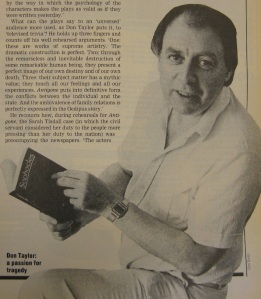 Oedipus at Colonus, however, was more interesting and engaging (read my post here). Some production choices contributed to this, as did the nature of the tragedy which appears in some ways to be drawn on a more human scale and thus appears to be emotionally accessible. The central roles of Oedipus and Antigone, played superbly by Anthony Quayle and Juliet Stevenson, added a great deal to my overall enjoyment of the production, despite abiding issues such as the glacier-like progress of the plot. It was Juliet Stevenson’s performance in particular which made me eager to see the final part of the trilogy.
Oedipus at Colonus, however, was more interesting and engaging (read my post here). Some production choices contributed to this, as did the nature of the tragedy which appears in some ways to be drawn on a more human scale and thus appears to be emotionally accessible. The central roles of Oedipus and Antigone, played superbly by Anthony Quayle and Juliet Stevenson, added a great deal to my overall enjoyment of the production, despite abiding issues such as the glacier-like progress of the plot. It was Juliet Stevenson’s performance in particular which made me eager to see the final part of the trilogy.
Sophocles’ Antigone is set in the aftermath of the death of Oedipus’ sons Eteocles and Polyneices by each other’s hands. They fought for the kingdom of Thebes, which is now ruled by Creon, their uncle. Creon considers Polyneices ‘an enemy of the state’ (in Taylor’s translation) and thus forbids burial of his body, a decree which Antigone, their sister, refuses to accept. The crux of the play is this fierce clash of wills between Creon and Antigone: Antigone defies the decree by performing burial rites; Creon immures Antigone in a cave. These actions have further devastating consequences: Antigone hangs herself in the cave, her betrothed – Haemon, Creon’s son – commits suicide, as does Creon’s wife Eurydice, in despair.
 The production opens with a massive photographic portrait of Creon being hung in a large open space which is the starkly proportioned inner chamber of the royal palace. When the camera pans back we see that this is just one of several identical portraits echoing around this one space (see adjacent image), a design choice which speaks ominously of the nature of Creon’s reign. The high (albeit stone) ceiling gives the space the feeling of an atrium, on the sides are tall sets of double doors and a steep flight of about thirty steps leading to a second set of doors. This is a significant contrast with Oedipus the King in which all the action took place in the space before the palace, according to ancient Greek dramatic convention. Antigone, without doubt, offers the most successful set of the three productions.
The production opens with a massive photographic portrait of Creon being hung in a large open space which is the starkly proportioned inner chamber of the royal palace. When the camera pans back we see that this is just one of several identical portraits echoing around this one space (see adjacent image), a design choice which speaks ominously of the nature of Creon’s reign. The high (albeit stone) ceiling gives the space the feeling of an atrium, on the sides are tall sets of double doors and a steep flight of about thirty steps leading to a second set of doors. This is a significant contrast with Oedipus the King in which all the action took place in the space before the palace, according to ancient Greek dramatic convention. Antigone, without doubt, offers the most successful set of the three productions.
The central playing space is empty save for (when needed) chairs, a throne and a large (but, perhaps significantly, empty) desk. The tight choreography of the twelve-strong chorus of Theban Elders is used effectively to give this cavernous space focus. This is not to say that their performance is very much more dynamic than in the previous two plays, but they do seem to have relaxed somewhat into their roles by this point in the trilogy and they do deliver their lines with more emotional range (although the formality of their strictly choreographed movements and unison speaking still restrains their performance). Before the Chorus enter, Ismene begs her sister not to think of defying their uncle Creon’s decree: ‘Think for a moment, Antigone, please! We’re women, that’s all. Physically weaker and barred from any political influence. How can we fight against the institutionalised strength of the male sex? They are in power and we have to obey them or worse tyrannies than these may be inflicted upon us’. And, indeed, ‘the institutionalised strength of the male sex’ is effectively illustrated as the score ushers in this group of middle-aged, mainly grey-haired men in their black suits and gowns, white shirts and ruffled ties, greeting each other with chummy handshakes.
Creon is a typical tyrant – angry, controlling, suspicious and paranoid. He considers the sisters to be ‘terrorists’ and ‘neurotic lunatics’. Don Taylor’s translation wears its heart on its sleeve. Antigone’s appeal to ‘common human decency’ and ‘ancient truths’ as the justification for performing burial rites for her dead brother in contravention of Creon’s decree is pitted against his ‘arrogance’ which is merely masquerading as ‘patriotism’ and ‘civic duty’. When brought before her uncle, she tells him that ‘it’s your law, not the law of god. Natural justice – which is of all times and places, numinous not material, a quality of Zeus not of kings – recognises no such law’.
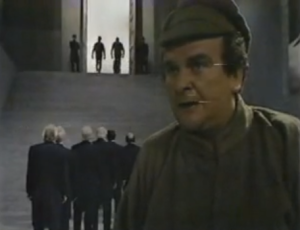 Tony Selby as the guard (named Soldier in this version) who comes to report that the body of Polyneices has been buried is entertaining: he is full of bluster, garrulous and cheeky, but clearly terrified. Creon threatens him: he must find the culprit or ‘be made a public example and interrogated by the Special Police, kept standing, beaten across the feet, the whole repertoire of special techniques at which we excel so much’. We see Creon exit from the top of the stairs he ascends, past the helmeted soldiers whose appearance suggests the ‘Special Police’ of which Creon spoke, and then we cut to ground level (see adjacent image) where we observe the poor soldier walking towards the camera admitting to himself that he didn’t think he was going to get out of that encounter alive and that he won’t be coming back in a hurry (Antigone, lines 328-331). This is a nice use of space and cameras.
Tony Selby as the guard (named Soldier in this version) who comes to report that the body of Polyneices has been buried is entertaining: he is full of bluster, garrulous and cheeky, but clearly terrified. Creon threatens him: he must find the culprit or ‘be made a public example and interrogated by the Special Police, kept standing, beaten across the feet, the whole repertoire of special techniques at which we excel so much’. We see Creon exit from the top of the stairs he ascends, past the helmeted soldiers whose appearance suggests the ‘Special Police’ of which Creon spoke, and then we cut to ground level (see adjacent image) where we observe the poor soldier walking towards the camera admitting to himself that he didn’t think he was going to get out of that encounter alive and that he won’t be coming back in a hurry (Antigone, lines 328-331). This is a nice use of space and cameras.
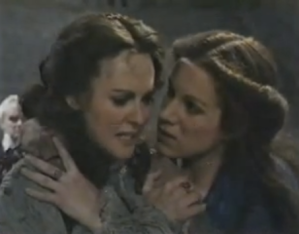 Antigone is not as fiercely angry with her sister for retrospectively trying to claim some responsibility for the burial as she is sometimes in performance. In fact, half of their conversation is delivered in soothing tones, with Antigone comforting her sister in an embrace (see image, adjacent). Furthermore, Taylor attributes some of Ismene’s lines (about the betrothal of Antigone and Creon’s son Haemon) to the Chorus, so that at this early point in the play the Elders are seen to question his decision to tear the couple apart by sentencing her to death.
Antigone is not as fiercely angry with her sister for retrospectively trying to claim some responsibility for the burial as she is sometimes in performance. In fact, half of their conversation is delivered in soothing tones, with Antigone comforting her sister in an embrace (see image, adjacent). Furthermore, Taylor attributes some of Ismene’s lines (about the betrothal of Antigone and Creon’s son Haemon) to the Chorus, so that at this early point in the play the Elders are seen to question his decision to tear the couple apart by sentencing her to death.
Haemon’s lines too are recast to serve Taylor’s interpretation of the play: instead of making an appeal to the prerogatives of ‘the gods’, Haemon (played by Mike Gwilym) echoes Antigone by speaking of ‘moral feeling’ and ’common humanity’. To drive home the point that Creon’s dictatorial position is unacceptable, Taylor interpolates a little dialogue around line 755: Haemon asks his father, ‘Is anyone else allowed to speak? Must you have the last word in everything? Must all the rest of us be gagged?’; Creon (struggling for air) replies, ‘I must … and I will. […] I will not be sneered at or contradicted by anyone.’ The pitch of anger in John Shrapnel’s Creon here is impressive.
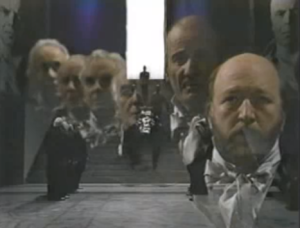 At a couple of points a nice televisual effect is achieved by superimposing facial close-ups of a handful of Theban Elders, as they deliver their lines, over an image of main characters descending the tall flight of steps. One of these is the entrance of Antigone arriving to face her death sentence (the second, illustrated here, is when Creon follows the entrance of his son’s corpse). She descends the steps slowly, having replaced her long blue dress with a white one, the train of which falls elegantly down the stairs in the style of a bridal dress. This change of costume is significant given the play’s theme of her imminent ‘marriage to death’. The chorus describe Antigone as ‘calm as a bride, going to her bed-chamber, to marry the dead and share their everlasting sleep’ and Antigone addresses Death as ‘my bridegroom’. This poetic ‘marriage to death’, which is made equally much of in the Sophoclean play, encourages the idea that this Antigone – whom the Chorus describe as ‘glorious, beautiful, unmarked, untouched’ – takes her place in the long Christian tradition of virgin martyrs.
At a couple of points a nice televisual effect is achieved by superimposing facial close-ups of a handful of Theban Elders, as they deliver their lines, over an image of main characters descending the tall flight of steps. One of these is the entrance of Antigone arriving to face her death sentence (the second, illustrated here, is when Creon follows the entrance of his son’s corpse). She descends the steps slowly, having replaced her long blue dress with a white one, the train of which falls elegantly down the stairs in the style of a bridal dress. This change of costume is significant given the play’s theme of her imminent ‘marriage to death’. The chorus describe Antigone as ‘calm as a bride, going to her bed-chamber, to marry the dead and share their everlasting sleep’ and Antigone addresses Death as ‘my bridegroom’. This poetic ‘marriage to death’, which is made equally much of in the Sophoclean play, encourages the idea that this Antigone – whom the Chorus describe as ‘glorious, beautiful, unmarked, untouched’ – takes her place in the long Christian tradition of virgin martyrs.
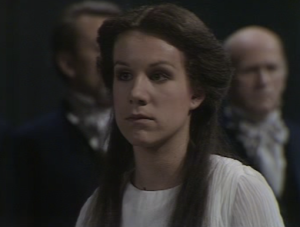 Juliet Stevenson in the title role is, as she was in Oedipus at Colonus, superb. Her performance of Taylor’s adaptation of Sophocles unambiguously ‘normalises’ Antigone, making the extremity of her moral position seem understandable, praiseworthy, even. She embodies the ‘human decency’ of which she frequently speaks. This moves away from the complexity of the ancient play: Antigone, in this production (as in many modern productions), is our goodie and Creon our baddie: we are not asked to dwell on the awkwardness inherent in her moral position – that she would go so far as to risk a life, her own life, to perform burial rites for a relative. An honourable burial was certainly hugely important in ancient Greek society, but the living were not obligated to sacrifice themselves in order to honour of the dead. Furthermore, respect for authority was important and women held a subordinate position in (so-called democratic) 5th-century Athens when this play was performed: her behaviour may have been seen as provocative and threatening to the status quo. The seer Tiresias declares that Polyneices should have received an honourable burial and Antigone not buried alive, but does not declare that Antigone was in the right. Her religious and moral position is, in the Sophoclean play, as extreme and inflexible as is Creon. Her final words before she exits (to sympathetic music) declare that she dies ‘unjustly, for upholding justice and the humanity of humankind’, summing up Taylor’s reading of the play’s moral compass (the original Greek at line 943 of the original play speaks more of doing reverence where reverence was due).
Juliet Stevenson in the title role is, as she was in Oedipus at Colonus, superb. Her performance of Taylor’s adaptation of Sophocles unambiguously ‘normalises’ Antigone, making the extremity of her moral position seem understandable, praiseworthy, even. She embodies the ‘human decency’ of which she frequently speaks. This moves away from the complexity of the ancient play: Antigone, in this production (as in many modern productions), is our goodie and Creon our baddie: we are not asked to dwell on the awkwardness inherent in her moral position – that she would go so far as to risk a life, her own life, to perform burial rites for a relative. An honourable burial was certainly hugely important in ancient Greek society, but the living were not obligated to sacrifice themselves in order to honour of the dead. Furthermore, respect for authority was important and women held a subordinate position in (so-called democratic) 5th-century Athens when this play was performed: her behaviour may have been seen as provocative and threatening to the status quo. The seer Tiresias declares that Polyneices should have received an honourable burial and Antigone not buried alive, but does not declare that Antigone was in the right. Her religious and moral position is, in the Sophoclean play, as extreme and inflexible as is Creon. Her final words before she exits (to sympathetic music) declare that she dies ‘unjustly, for upholding justice and the humanity of humankind’, summing up Taylor’s reading of the play’s moral compass (the original Greek at line 943 of the original play speaks more of doing reverence where reverence was due).
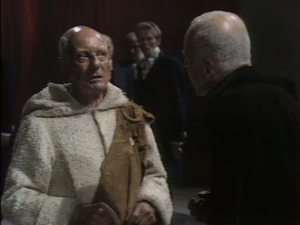 This play is, of course, only to some extent about Antigone and her fate. After her exit, the entrance of Teiresias injects new energy into the play at the pivotal point when the focus shifts wholly to Creon. John Gielgud, with his easy gravitas, reprises the role of the blind seer from Oedipus the King. Teiresias warns Creon in no uncertain terms that he was wrong to be so inflexible and Creon eventually realises his folly. He exits, determined to try to put things right by burying the body of his nephew and releasing Antigone from her sealed-up cave.
This play is, of course, only to some extent about Antigone and her fate. After her exit, the entrance of Teiresias injects new energy into the play at the pivotal point when the focus shifts wholly to Creon. John Gielgud, with his easy gravitas, reprises the role of the blind seer from Oedipus the King. Teiresias warns Creon in no uncertain terms that he was wrong to be so inflexible and Creon eventually realises his folly. He exits, determined to try to put things right by burying the body of his nephew and releasing Antigone from her sealed-up cave.
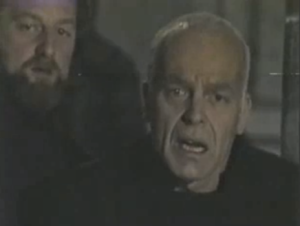 After a choral ode, a Messenger relates the sorry tale of how Creon yielded too late. Antigone had already committed suicide and Haemon, clutching at her body, followed her example in front of his father: the Messenger describes them as ‘Two corpses, married at last. Whom death has joined no man can put asunder. They looked like honeymooners together in one bed. Evidence of the havoc man can bring upon man with his own pig-headedness and arrogance‘ (the Greek refers here to Creon with the milder term ‘folly’). Creon’s wife Eurydice hears the Messenger’s awful news about the death of her son and departs silently; she, too, is soon discovered having taken her own life.
After a choral ode, a Messenger relates the sorry tale of how Creon yielded too late. Antigone had already committed suicide and Haemon, clutching at her body, followed her example in front of his father: the Messenger describes them as ‘Two corpses, married at last. Whom death has joined no man can put asunder. They looked like honeymooners together in one bed. Evidence of the havoc man can bring upon man with his own pig-headedness and arrogance‘ (the Greek refers here to Creon with the milder term ‘folly’). Creon’s wife Eurydice hears the Messenger’s awful news about the death of her son and departs silently; she, too, is soon discovered having taken her own life.
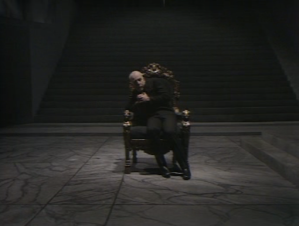 As illustrated above, Creon walks behind the corpse of his son, brought in on a stretcher in the manner of the ancient Greek ekkyklema, the platform which was rolled onto the stage in order to show to the audience the results of actions (often suicides or murders) which took place off stage. But – strikingly – when the already broken Creon hears about his wife’s suicide, the Chorus urge him to ‘Open the door and see for yourself’. He does so and, for the first time in the trilogy (ignoring the fact that the playing space has the feel of an atrium, technically, then, an ‘indoors’ scene), we see, briefly, indoors – we catch sight of his wife’s body, lit in red, lying lifeless against an altar. We watch his horrified face from within this chamber as he speaks of his ‘unendurable pain’. Over his shoulder (as in the penultimate image here) the Messenger (who according to Greek dramatic convention arrived early enough to hear her dying words and observe her actions but too late to intervene) tells him how she cursed her husband as their son’s murderer. Creon is helped into his throne where he sits, dishevelled, utterly broken and almost lifeless with grief (as shown here, in the final image). The Chorus close the play in the traditional tragic manner with a series of wise words. Above all, they say, man must ‘stand in awe of eternal, unalterable law’, underscoring Taylor’s interpretation of the play.
As illustrated above, Creon walks behind the corpse of his son, brought in on a stretcher in the manner of the ancient Greek ekkyklema, the platform which was rolled onto the stage in order to show to the audience the results of actions (often suicides or murders) which took place off stage. But – strikingly – when the already broken Creon hears about his wife’s suicide, the Chorus urge him to ‘Open the door and see for yourself’. He does so and, for the first time in the trilogy (ignoring the fact that the playing space has the feel of an atrium, technically, then, an ‘indoors’ scene), we see, briefly, indoors – we catch sight of his wife’s body, lit in red, lying lifeless against an altar. We watch his horrified face from within this chamber as he speaks of his ‘unendurable pain’. Over his shoulder (as in the penultimate image here) the Messenger (who according to Greek dramatic convention arrived early enough to hear her dying words and observe her actions but too late to intervene) tells him how she cursed her husband as their son’s murderer. Creon is helped into his throne where he sits, dishevelled, utterly broken and almost lifeless with grief (as shown here, in the final image). The Chorus close the play in the traditional tragic manner with a series of wise words. Above all, they say, man must ‘stand in awe of eternal, unalterable law’, underscoring Taylor’s interpretation of the play.
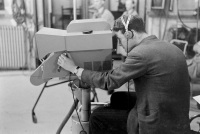
Does anyone know how to get a copy of this production on dvd?
Posted by Adrian Blakey | 5 November 2012, 9:25 pmIt’s not available on DVD, Adrian, but you can view it through the research viewing service at the BFI Southbank.
Posted by Amanda Wrigley | 5 November 2012, 9:44 pmThe DVD of Antigone is now available from mediaoutlet.com priced at $8.49. Unfortunately the other plays in the cycle are not available.
Richard
Posted by Richard Potter | 6 April 2013, 4:59 pmThank you, Richard, for noting that Antigone is available to purchase! Hope things are going well for you.
Posted by Amanda Wrigley | 8 April 2013, 7:09 amWow. This was a…..really really fascinating read. I stumbled upon it quite by chance when I was just trying to find the correct spelling for Antigone, and then recognized the stills from when I watched this version when I was eight years old. I was intrigued and decided to read a bit of the article and ended up being sucked in. It was really very very interesting.
I’d also be interested in knowing your thoughts on Jean Anouilh’s version of the story (if you’ve ever seen it).
Posted by Holly(Woods) | 9 February 2015, 8:09 pmThanks for writing, Holly. I wonder what your eight-year-old self thought of this Greek tragedy? So pleased you enjoyed the article above! I don’t know the Anouilh as well, I admit, but it’s time to rectify that. Perhaps a blog post will be forthcoming on the 1959 BBC version of Anouilh’s Antigone before long?
Posted by Amanda Wrigley | 10 February 2015, 9:19 amIf you decide to write about Anouilh’s Antigone I’ll be sure to read it :-)
At eight…oh I don’t remember having much impression other then ‘this is better than school work’, but my sister (who is three years older than me and has always had a love of theater and plays) decided we must perform our own Greek tragedy, written by her (I’m not sure any of us realized that it could only be Greek if it were actually written by Greeks), it was complete with a chorus and everyone dying at the end.
Posted by Holly(Woods) | 19 February 2015, 1:35 amThe 1974 version of Anouilh’s Antigone is quite good as well.
Posted by Holly(Woods) | 19 February 2015, 1:37 amI am very interested in the text of the translation used in this production, because of the lucidity and modernity of the language used. Can you advise if the text of this translation is available, or who I might ask to pursue it? (nathanzamprogno@gmail.com here- please feel free to email me).
Posted by Nathan Zamprogno | 18 August 2015, 10:25 amHi Nathan. A version of Don Taylor’s translation of Antigone was published in 2012 by Bloomsbury (http://www.amazon.com/Antigone-Modern-Plays-Sophocles/dp/1408173239), but I’ve not had the chance to compare this recent publication with the television script from 1986. Amanda
Posted by Amanda Wrigley | 19 August 2015, 2:23 pmAmanda…hello
I too stumbled across your review, searching for whether the soldier (sentry in the play) – actor Tony Selby – spoke intentionally with a “common man” British accent rather than the more refined (regal?) accents of Antigone, Creon, and the Chorus. Do you have any insight on this idea?
btw: I teach high school English and have shown excerpts of the BBC production in class…very worthwhile
thanks…Barb Honda
Posted by Barbara Honda | 17 October 2015, 2:33 pmOh, that Taylor’s Theban plays were again available as DVDs. Too excellent to leave to oblivion.
Posted by kootenaycoyote | 25 April 2021, 12:32 am